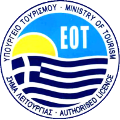Vergina represents exceptional testimony to a significant development in European civilization, at the transition from the classical city-state to the imperial structure of the Hellenistic and Roman periods. This is vividly demonstrated in particular by the remarkable series of royal tombs and their rich contents. The paintings found at Vergina are of extraordinarily high quality and historical importance.
The ancient city in the northern foothills of the Pierian range is the capital of the kingdom of Lower Macedonia, Aigai, traditionally founded by Perdiccas I when the Macedonians of the Argive spread northwards over the plain of Emathia. This region was already settled in the early Bronze Age (3rd millennium BC), as evidenced by a tumulus (grave-mound) near the river Haliakmon. The wealth and density of over 300 grave-mounds in the Cemetery of the Tumuli testifies to the importance of Aigai in the early Iron Age (1100-700 BC). As the capital of the Macedonian kingdom and site of the royal court, Aigai was the most important urban centre in the region throughout the archaic period (800-500 BC) and the following century. The grave-goods in a series of tombs dating from the 6th and 5th centuries BC demonstrate commercial and cultural links with Greek centres of eastern lonia and the south. At the end of the 5th century, Archelaus brought to his court artists, poets and philosophers from all over the Greek world.
Although the administrative centre was transferred to Pella in the 4th century BC, Aigai retained its role as the sacred city of the Macedonian kingdom, the site of the traditional cult centres, and the royal tombs. It was here in 336 BC that Philip II was assassinated in the theatre and Alexander the Great was proclaimed king. The bitter struggles between the heirs of Alexander, the Diadochoi, in the 3rd century adversely affected the city, and it was further slighted after the overthrow of the Macedonian kingdom by the Romans in 168 BC. Nevertheless, it was rebuilt and survived into early imperial times. However, between the 2nd and 5th centuries AD the population progressively moved down from the foothills of the Pierian range to the plain, so that all that remained was a small settlement whose name, Palatitsia (palace), alone indicated its former importance.
The most important building so far discovered is the monumental palace, located on a plateau directly below the acropolis. This building, which rose to two and perhaps three storeys, is centred on a large open courtyard flanked by stone Doric colonnades. The rooms were used for religious, administrative, and political functions. On the north side was a large gallery that commanded the stage of the neighbouring theatre and the whole Macedonian plain. It was sumptuously decorated, with mosaic floors, painted plastered walls, and fine relief tiles. The theatre, from the second half of the 4th century BC, forms an integral part of the palace complex. Just to the north there is a sanctuary of the goddess Eukleia, with small 4th and 3rd centuries BC temples containing statue bases inscribed with the names of members of the Macedonian royal family.
The best known feature of the site is the necropolis, which extends for over 3 km, with the Cemetery of the Tumuli at its heart. This contains over 300 grave-mounds, some as early as the 11th century BC. To the north-west of the ancient city there is an important group of tombs from the 6th and 5th centuries BC belonging to members of the Macedonian dynasty and their courts. These contained rich funerary deposits, along with imported materials. One from around 340 BC with an imposing marble throne, is believed to be that of Euridike, mother of Philip II. The most impressive funerary monument is the Great Tumulus, an artificial mound 110 m in diameter and 13 m high, beneath which four elaborate royal tombs were discovered. One contains wall paintings representing the rape of Persephone, believed to be the work of the famous painter Nikomachos. Two of the tombs were undisturbed in antiquity and both contained rich grave-goods. In Tomb II the body was found in a solid gold casket weighing some 11 kg; the occupant has been identified as Philip II, father of Alexander the Great and consolidator of Macedonian power. This tomb is especially noteworthy for the frieze that adorns it, believed to be the work of the celebrated Philoxenos of Eretria.










